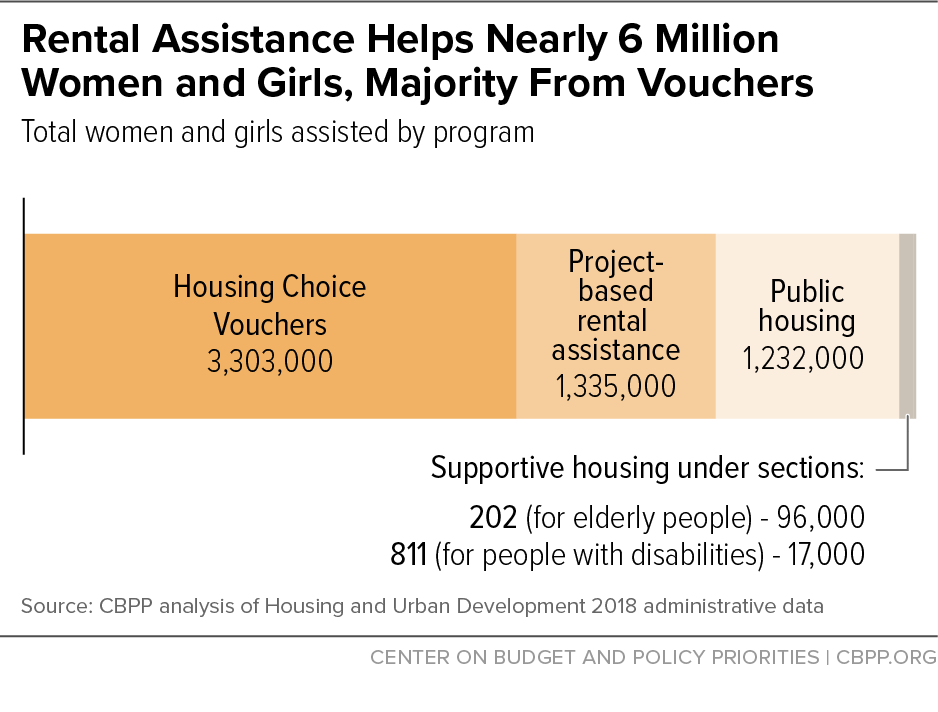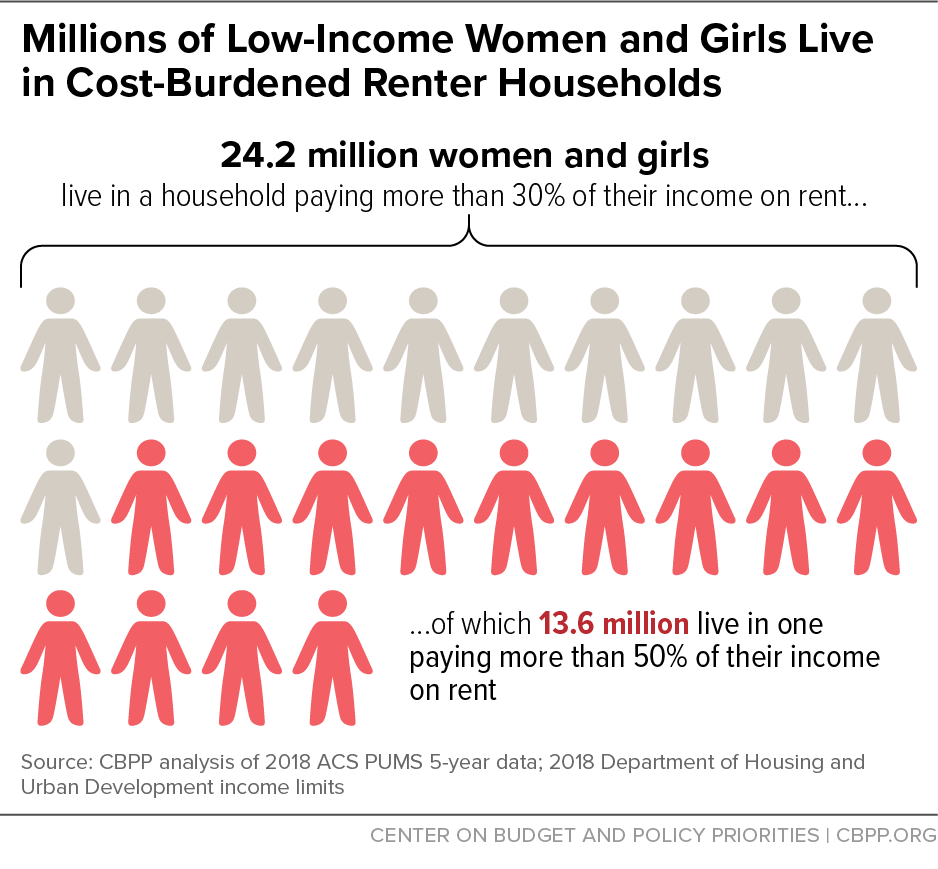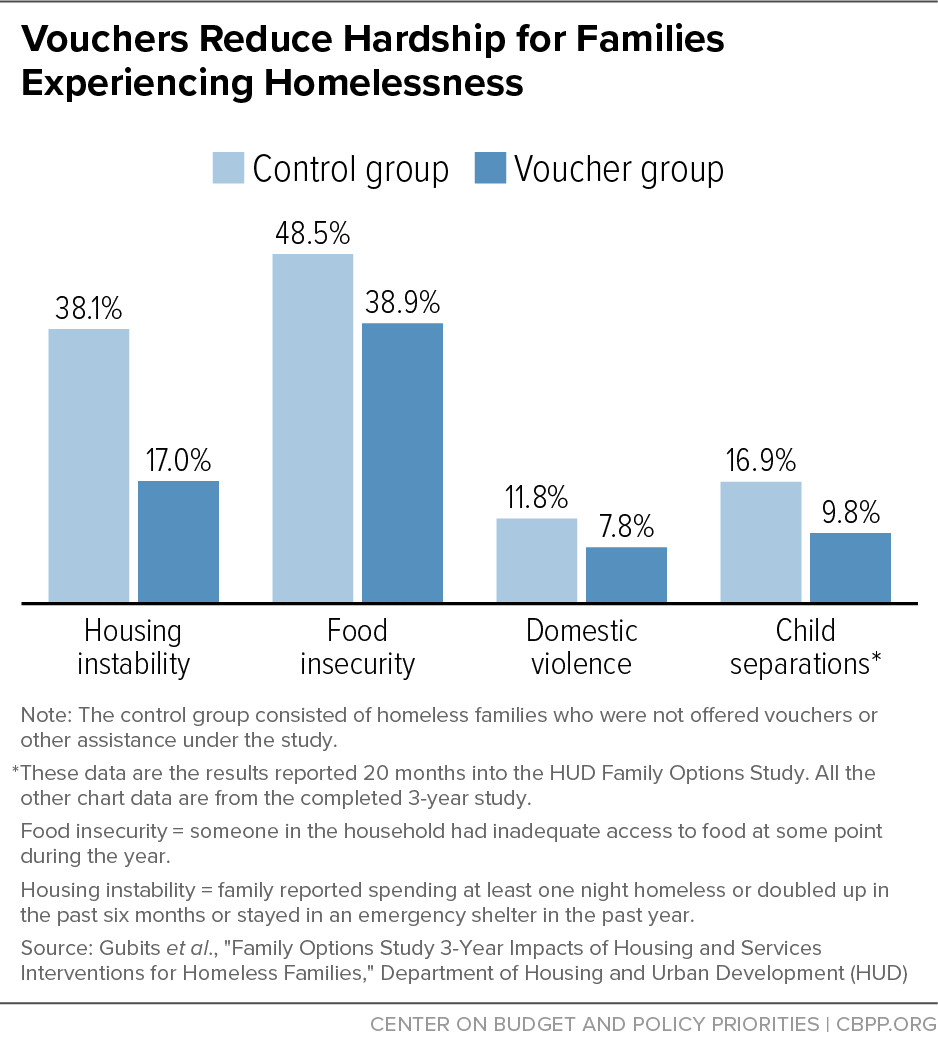More Housing Vouchers Needed to Help Women and Girls Afford Safe, Stable Homes
Safe, stable, accessible, and affordable housing remains out of reach for millions of women and girls in the U.S., which can undermine their health, safety, and economic opportunity. To address these problems long term, policymakers should make a Housing Choice Voucher available to every eligible household. They should start by enacting recovery legislation, which includes a significant expansion of the program.
Vouchers have proven highly effective at keeping people with low incomes, including women, stably housed. Vouchers typically help families rent, in the private market, a modest unit they choose in the neighborhood they choose. Families pay about 30 percent of their income for rent and utilities and vouchers cover the rest, up to a cap based on local market rents.
Vouchers deliver major benefits to over 3 million women and girls nationwide, more than any other rental assistance program. (See Figure 1.) But they could do much more if made available to the millions now eligible but unassisted due to inadequate funding. Some programs such as Medicaid automatically expand to serve all who qualify; rental assistance does not but should. Just 1 in 4 families eligible for rental assistance receive it, and waiting lists for vouchers are years-long in much of the country. The lack of universal rental assistance during the COVID-19 crisis led to millions of women — particularly women of color — and their families falling behind on rent.
Among its many benefits, a voucher program expansion would:
1. Provide Economic and Housing Stability, Advance Racial Equity
Voucher expansion could make housing affordable for over 13 million women and girls living in households paying more than half their income toward rent. (See Figure 2.) Providing vouchers to all eligible households would lift 5 million women and girls above the federal poverty line, one study estimated, cutting this group’s poverty rate by 22 percent. The rate would fall even more for Black and Latina women, who — due to our nation’s long history of racism and discrimination — face disproportionately high rates of poverty and housing problems including rental cost burdens, overcrowding, evictions, and homelessness.
Women experience economic insecurity at higher rates than men due to systemic sexism, such as long-standing gender pay and wealth gaps and the lack of paid family leave (which affects women more since they often have greater caregiving responsibilities). These inequities persist throughout women’s lives as many women earn less over their lifetime than men on average and, consequently, save an average of 30 percent less for retirement than men. High rent costs can force low-income women to spend a high share of their income on rent, limiting how much they can spend on other essential needs such as food, child care, and health care. Women, particularly Black and Latina women, are evicted at higher rates than men. Evictions harm long-term mental health, interrupt children’s education, and undermine families’ ability to secure housing in the future.
Vouchers make a family’s rental costs affordable, enabling women to spend more on basic needs and goods and services that enrich their and their children’s lives. Vouchers also give families more choices about where they live, improving access to neighborhoods with more resources. A long-term study found that children whose families used vouchers to move from high- to low-poverty neighborhoods — which often have better-resourced, higher-performing schools — had substantially higher adult incomes and rates of college attendance than similar children whose families stayed in low-income neighborhoods. Girls had reduced risks of depression and other mental health improvements, and adults also experienced better health outcomes.
2. Sharply Reduce Homelessness Among Women and Girls
Voucher expansion is critical to ending homelessness for the hundreds of thousands of women and girls living in shelters or on the streets each year. More than 220,000 women and girls were staying in homeless shelters or living on the street in January 2020, when communities across the country conducted the annual point-in-time count required by the Department of Housing and Urban Development. That was 12 percent higher than the year before and does not account for any likely rises due to the COVID economic crisis. In addition, the number of unsheltered women and girls experiencing homeless has increased by 37 percent since 2015, which puts them at higher risk of sexual assault and other violence. Women and girls make up 60 percent of individuals in families with children experiencing homelessness, and women headed nearly 90 percent of sheltered families.
A broad body of research shows that rental assistance is highly effective at reducing homelessness and housing instability, with other benefits including improved food security and fewer instances of children being separated from their families. (See Figure 3.) Voucher expansion would ensure that women could afford housing and avoid homelessness, which may harm them and their children. Significantly expanding vouchers would be transformative, enabling communities to create a homelessness response system that quickly rehouses women and girls, eventually making homelessness brief and rare. It would also advance equity for Black and Latina women, transgender women, and other groups with much higher homelessness rates than the general public.
Rental assistance and short-term support in navigating the rental market are enough for most people to regain long-term housing stability. However, some women will need supportive housing, an evidence-based solution that pairs rental assistance with services such as intensive case management, ongoing housing navigation, and physical and behavioral health services for those who want them. Supportive housing can improve access to quality physical and behavioral health care while reducing incarceration and use of costly systems such as emergency health services or nursing homes. Vouchers are particularly well-suited for increasing access to supportive housing. Vouchers can be tenant-based, letting people choose a unit on the private market, or project-based, meaning the rental assistance is tied to specific units.
3. Help Women and Girls Secure Safe and Permanent Housing
Housing instability contributes to violence against women and vice versa. Women (including many with children) report that domestic violence is a leading cause of their homelessness. And women experiencing domestic violence are often cut off from financial resources by their abusive partners, preventing them from safely securing housing. While some public housing authorities that administer housing vouchers prioritize vouchers for survivors of domestic violence, waiting lists are so long that many survivors must wait months or years to receive the much-needed rental assistance. More than half of the requests for housing assistance from survivors go unmet each year. Lack of housing assistance leaves survivors at risk of homelessness and additional harm from their abuser.
Research shows that providing housing vouchers to homeless families reduces the incidence of domestic violence. (See Figure 3.) Long-term housing assistance allows women to more safely exit dangerous relationships and establish independence. Expanding housing vouchers would give thousands of survivors the choice to move away from their abusers and into safe homes where they and their children can thrive.
Women and girls too commonly experience sexual assault, human trafficking, and other forms of violence, especially when living outdoors or in congregate shelters. For instance, more than 1 in 4 women in Los Angeles who experience long or repeated homelessness reported experiencing sexual assault in the last year. And over half of women experiencing homelessness or housing instability in Washington, D.C. reported experiencing some form of violence or a threat to their safety. By preventing and reducing homelessness, expanding vouchers would also help reduce violence against women.


